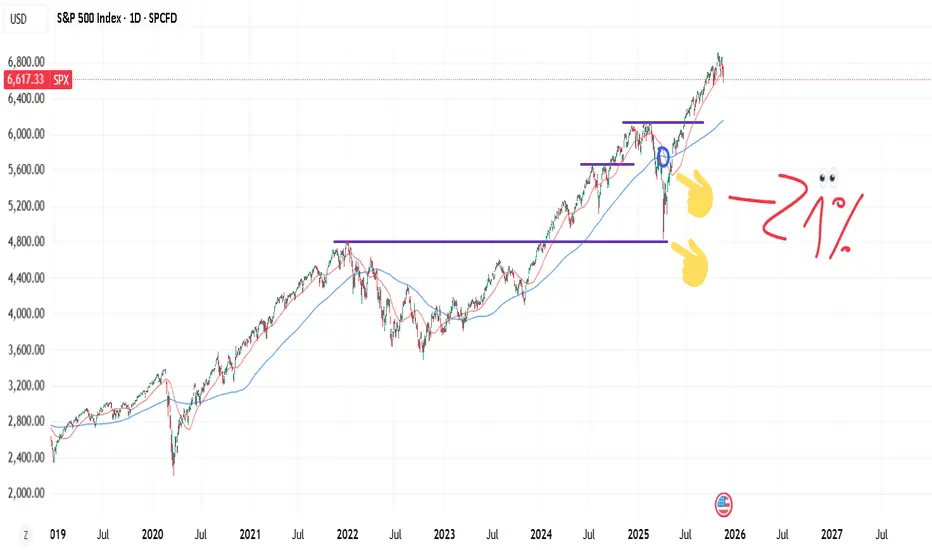Cognitive Bias is how you or your brain process or interpret information. What you strongly believe in. (Influenced by beliefs, expectations, emotions, and shortcuts).
Prejudgment could be things that are "most of time true, but not always". Learned truths that can be false. (Prejudgment is treating a general rule as always true).
... markets move based on Supply-Demand dynamic, structural positioning and "least resistance". Markets follow the economy. And there are merits to using quant statistics.
Prejudgment: (Based on DOW theory or Tudor Jones upsloping 200dma) - there is less risk buying strong bull markets. When DOW is broken, price bellow 200dma - it means bear market. In practice this was a statistical scarce spot where big money is made.
-20% is usually a good indicator as well as bottom for the top1% stocks? as well in bitcoin, that wouldn't fall that much.
Prejudgment: Stocks follow the economy (true), tariffs pose risks to economy ie cause recession, hence a bear market.
Statistically, based on like previous 6 years, every sharp drop gets re-filled instantly. ie the V shape recoveries. mirroring 2020. There was a positional imbalance.
Cognitive Bias: trending near the bottom ---> affirms your fears of crash. or bubble talks. Prices follow S-D dynamic, not charts.
Another one is believing that most people are in fear. Which equates a crash.
cognitive biases in short -- you favor or over emphasize the importance of near term events over longterm proven statistics. Markets repeat over and over again, in same psychological patterns.
Prejudgment could be things that are "most of time true, but not always". Learned truths that can be false. (Prejudgment is treating a general rule as always true).
... markets move based on Supply-Demand dynamic, structural positioning and "least resistance". Markets follow the economy. And there are merits to using quant statistics.
Prejudgment: (Based on DOW theory or Tudor Jones upsloping 200dma) - there is less risk buying strong bull markets. When DOW is broken, price bellow 200dma - it means bear market. In practice this was a statistical scarce spot where big money is made.
-20% is usually a good indicator as well as bottom for the top1% stocks? as well in bitcoin, that wouldn't fall that much.
Prejudgment: Stocks follow the economy (true), tariffs pose risks to economy ie cause recession, hence a bear market.
Statistically, based on like previous 6 years, every sharp drop gets re-filled instantly. ie the V shape recoveries. mirroring 2020. There was a positional imbalance.
Cognitive Bias: trending near the bottom ---> affirms your fears of crash. or bubble talks. Prices follow S-D dynamic, not charts.
Another one is believing that most people are in fear. Which equates a crash.
cognitive biases in short -- you favor or over emphasize the importance of near term events over longterm proven statistics. Markets repeat over and over again, in same psychological patterns.
Ghi chú
Anchor bias: buying lows because it looks similar to 2020 crash. Before you lose it all. Follow the S-D.Ghi chú
Cognitive bias is seeing the past as a driver for future. When S-D is the driver. Bài đăng liên quan
Thông báo miễn trừ trách nhiệm
Thông tin và các ấn phẩm này không nhằm mục đích, và không cấu thành, lời khuyên hoặc khuyến nghị về tài chính, đầu tư, giao dịch hay các loại khác do TradingView cung cấp hoặc xác nhận. Đọc thêm tại Điều khoản Sử dụng.
Bài đăng liên quan
Thông báo miễn trừ trách nhiệm
Thông tin và các ấn phẩm này không nhằm mục đích, và không cấu thành, lời khuyên hoặc khuyến nghị về tài chính, đầu tư, giao dịch hay các loại khác do TradingView cung cấp hoặc xác nhận. Đọc thêm tại Điều khoản Sử dụng.
